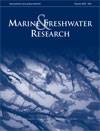Marine and Freshwater Research
Volume 65
Number 3 2014
Eutrophication has been common in coastal areas worldwide. In this study, we try to predict algal blooms in a lagoon by using N/P ratio. The results suggest that it could be used as an expedient and reliable measure of the potential eutrophic status of coastal lagoons.
Selection at pre-market ages can increase selection intensity, shorten generation time and thus increase genetic progress and reduce costs of breeding programs. Our estimates of genetic correlations between body trait expressions at Weeks 10 and 18 were very high and close to one, suggesting that pre-market bodyweight can provide an effective selection criterion for improving market bodyweight in freshwater prawn populations.
Our study revealed the variability in groundwater attributes and their impacts on vegetation succession in the lower Heihe River Basin, north-western China, where groundwater heterogeneity had an important impact on vegetation succession, and thus showed a prevalence of groundwater attributes-based niche differentiation among plant communities. Our study provides a scientific basis for the understanding of ecosystem restoration in similar regions.
Determining requirements of spawning fish is fundamental to understanding their reproductive and recruitment processes, as well as directing conservation efforts. Acoustic telemetry, in combination with icthyoplankton surveys, demonstrated estuary perch, Percalates colonorum, selected spawning habitat based on river location and structural complexity, with spawning events concentrated during the run out tide at night. This study demonstrated that availability of preferred spawning habitat may be a limiting factor in the spawning success of this species.
Blue swimmer crab is an important fishery resource and potential aquaculture species throughout the Indo-Pacific region. This study aimed to investigate the ontogenetic patterns of growth and lipid composition changes during the larval development of blue swimmer crab larvae. Our results provide important insights for the understanding of larval biology and lipid nutrition for this crab larva.
How do marine protected areas affect low-trophic-level fish assemblages? We studied the impact of total and partial fishing prohibition on a sedentary prey fish assemblage over a 10-year period and observed that fish densities were lower but more stable over time in the no-take zone. These findings suggest the restoration of trophic interactions in absence of all extracting activities.
Penaeid prawns in Ungwana Bay, Kenya, are, economically, a very important fishery. Since adult prawns may recruit from estuaries, we used a combination of genetic markers to show that singe genetic stocks exist in three of the dominant prawn species. Ecological and socio-economic factors are more important in managing the resource than the genetic delineation of stocks.
Establishing drivers of fish abundance in estuaries is an important task of theoretical and practical significance. In the present study, the application of the hydroacoustic method for quantification of fish has revealed that salinity, turbidity and flow can be correlated with fish biomass at a seasonal scale. This confirmed the previous hypothesis based on less rigorous catch-per-unit-effort data.
Despite roach, Rutilus rutilus, having been introduced to Australia in the mid-19th century, little ecological information exists for populations on the continent. The present study investigated key biological characteristics of R. rutilus in a large inland impoundment; latitudinal variation in environmental conditions are suggested as likely responsible for inter-population differences. Because of physiological restrictions, few rivers and impoundments in Australia are likely to provide sufficient habitat for the species.




